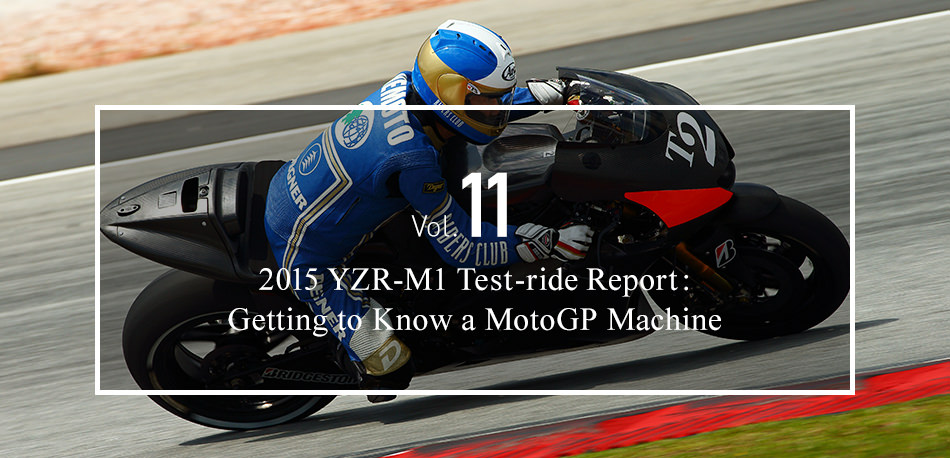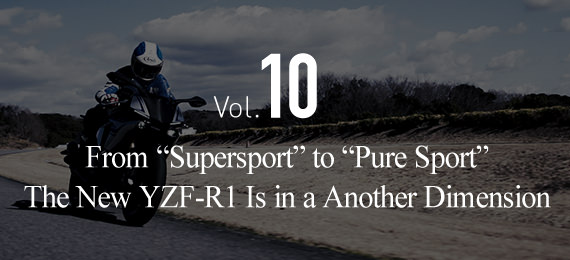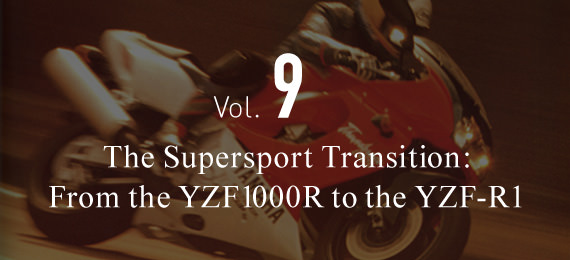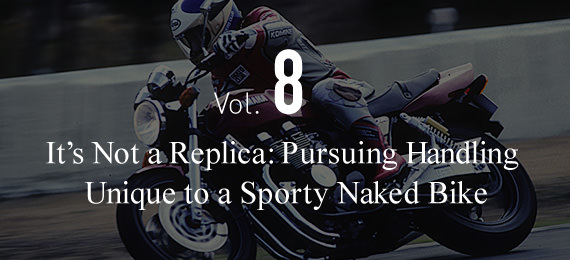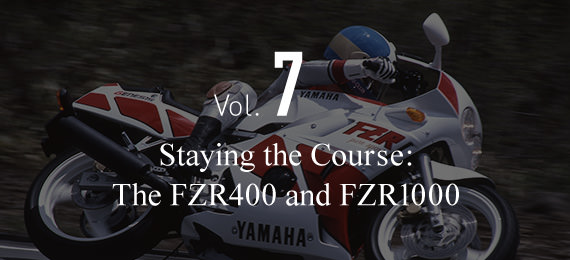Vol. 11 2015 YZR-M1 Test-ride Report: Getting to Know a MotoGP Machine
When I heard the almost unbelievable news that I would be given a chance to test-ride the YZR-M1 MotoGP machine, I could barely believe what I was hearing and nearly jumped for joy. But the feeling didn’t last long; the next moment I was overcome with anxiety.
When I had ridden the YZF-R1M and was so moved by its performance, I had realized that motorcycle electronics were no longer just rider-support functions; these next-generation devices are now an integral part of the whole R1 package. That realization made me to want to learn more about the YZR-M1, the advanced development platform that produces these cutting-edge technologies. Still, I didn’t think that one of the fastest motorcycles on Earth would easily accept anyone other than a MotoGP rider on its back, much like a prize racehorse. MotoGP bikes are said to have around 300 horsepower...even when I test-rode the new YZF-R1, talk of its amazing power made me anxious about putting it to the test. However, the result was a very enjoyable experience thanks to the way the machine receives a new rider so naturally and how it is both easy and fun to ride.
But I was sure there was no way the YZR-M1 could possibly be the same. What’s more, my test-ride would be on the same Sepang International Circuit where the Malaysia round of the MotoGP Championship is held. I was told that they would find a time for me to test-ride the YZR-M1 during the test sessions that each manufacturer holds a week before the official pre-season tests.
Ken Nemoto
Born in Tokyo, Japan in 1948.
Withdrew from Keio University's Faculty of Letters.
He began riding motorcycles at age 16, won the 750cc All Japan Road Race Championship title in 1973 and competed in the World GP from 1975 to 1978. After returning to Japan, he served as the editor in chief of RIDERS CLUB magazine for 17 years and also served in producing a wide variety of hobbyist magazines. Today, he competes in the AHRMA's classic motorcycle races at Daytona Speedway as part of his life work.
That meant I wouldn’t be riding a 2014 model that had finished its season, but the 2015 YZR-M1 that would be fighting for the title this year! The more I learned about this exceptional opportunity, the more reserved—and quite honestly, unworthy—I felt. As I worried, the day quickly approached, and before I knew it, the time had come for me to mount the YZR-M1 for my test-ride.
Lap 1 – One Very Nervous Sighting Lap
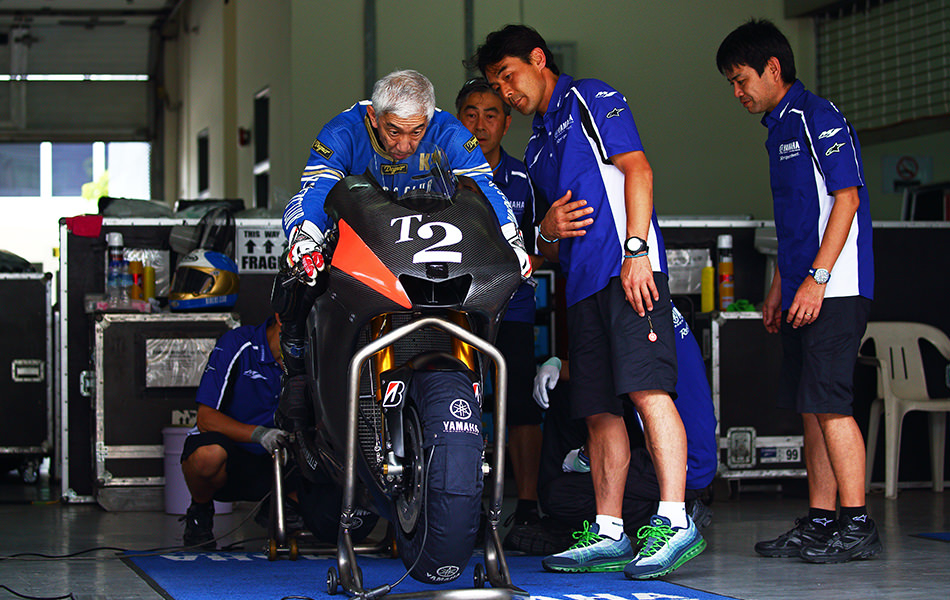
Even at the end of January, Kuala Lumpur is like midsummer in Japan with the temperature hovering around 32–34 °C. When I arrived at Sepang, I found the teams of the various manufacturers busily working on machine set-up. Bikes would head out for a few quick laps before returning to the pit for more adjustments and then heading out again in a seemingly endless loop. When the pit area had quieted down for a rather late lunch break, I was told the 2015 YZR-M1 was ready for my test-ride.
Not yet in its full colors with sponsor logos, the machine’s all-black carbon exterior cut a sharp look. I was given a simple explanation in front of the bike, the engine was started and I got on.
One big difference between the YZR-M1 and a regular bike is that you only need to use the clutch lever when shifting from neutral into 1st gear. Also, the neutral position is actually no longer usable through the clutch lever as soon as the machine is under power. It only goes back into neutral by pressing a button on the handlebar when you stop the machine. Otherwise, no use of the clutch lever is necessary for upshifting or downshifting. There are some production models now that don’t need the clutch for downshifting, but the YZR-M1 indeed has the “seamless” transmission that we’ve heard about lately. Thinking about things like this, I couldn’t even imagine what it would be like to ride.
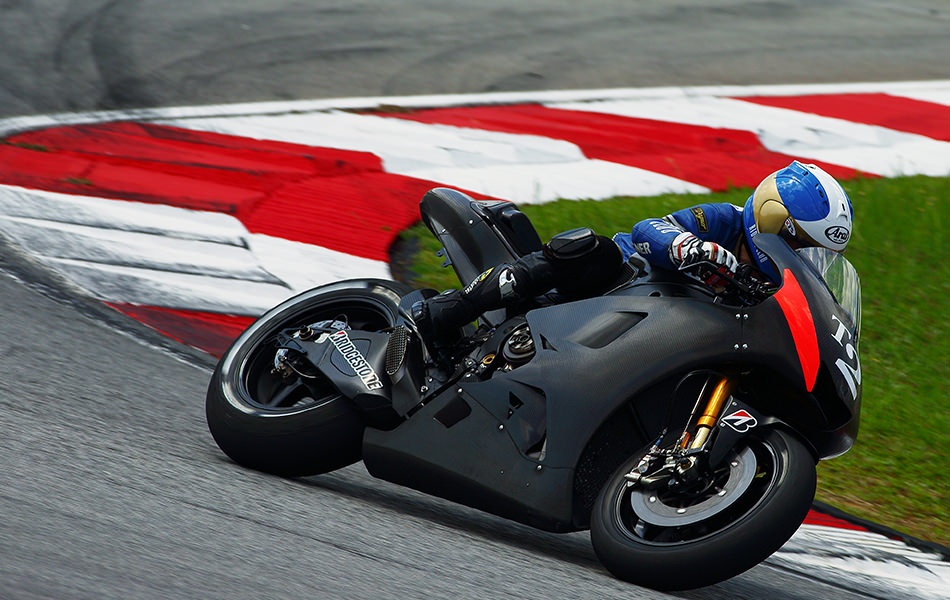
I was already extremely nervous about what lay ahead, but hearing the pre-ride explanation made me realize I was about to enter a completely unknown world. With my heart already feeling like it was about to burst, I shifted the engine into low gear out of its high-rpm idle—something characteristic of GP machines. Slowly engaging the clutch, I headed out onto the pit lane. Listening to the unique and mixed-wavelength rumble of the crossplane engine, I started by making an early upshift to 2nd gear before reaching 10,000 rpm. Although the machine’s cowling developed for high-speed aerodynamics appears large, I’m surprised by how compact and light the machine feels once I’m underway. It feels like everything in the machine is brought together in the center—right under my stomach—and it makes you forget that this is actually a 1,000cc machine. To me, the YZF-R1M had also felt small—on par with a 600cc model—but instead of feeling “small,” the YZR-M1 had a mystifying feeling, as if it lacked “mass” altogether.
But I could still clearly feel how the front and rear wheels were moving; it’s a different feeling from what one gets from a machine with an extremely short wheelbase where the rear wheel is right behind your bottom. As I left the pit lane and went into the first corner, the feeling was so clear that I found myself opening the throttle more than I expected. When I did, I could feel the force of the rear wheel against the pavement being dampened gently and then thrusting the machine forward. But then, I started wondering how I could be so calm about everything; this machine is capable of acceleration that could blow me off the seat, yet here I am asking myself if my nervousness was throwing my sense of balance off. Am I trapped in an illusion? No, what I was experiencing was unmistakably real.
I went through the first corner slowly and carefully, and after the changeover to the left, I entered the long right-hander, giving me plenty of vision of the pavement beyond. I decided to really open the throttle; the word “breakneck” isn’t sufficient to describe the burst of speed that followed. One thing I was certain of was that I had never experienced acceleration g-forces of this magnitude. The scenery around me would immediately blur, but I still didn’t have the feeling that I was being blown away.
Feeling dumbfounded by the unexpected “gentleness” of the awesome acceleration I was experiencing, I upshifted while I was still only about halfway to redline.
“I know what's going on,” I told myself. Ever since I started out on the pit lane, I’ve been under some kind of spell. Even though I’m used to not using the clutch lever and powershifting, this feeling is completely different from the usual slight change in speed that comes from the ignition cutting out during gear shifts. The sound of the exhaust tells me there’s a change in the engine rpm, but there’s absolutely no perceivable drop in drive force and the feeling of torque just continues to build linearly. Put differently, it felt like the YZR-M1 had a V-belt continuously variable transmission (CVT). As unbelievable as that may sound, that’s the only way I can describe what I felt.
There was an even bigger surprise in store for me when I started to downshift. When you simply flick the shift pedal up without touching the clutch lever, you hear a blipping in the exhaust note for just a split-second. But there’s no negative effect on the drive force from engine braking and the grip at the rear wheel remains constant. Dual-clutch transmissions that function the same way are appearing on some production models, but the smoothness of the YZR-M1’s gearbox is in a completely different dimension. This made me very curious to see what it would feel like to do this at half-throttle, so I tried it. The machine didn’t even blink; the smoothness was no different at all. The YZR-M1 had definitely cast some kind of spell on me.
Oh, right... I’ve only been allowed five laps on the machine. The other teams are waiting for me to finish before they resume their important pre-season tests. Remembering the advice I had been given about things like a corner “similar to the Degner Curve at Suzuka Circuit,” I spurred myself on to try staying on the best lines through the curves. I couldn’t let myself get carried away by this assault on my senses.
After riding through the hairpin, the S-curve and the track’s several connected corners, I came out onto the long back straight. Preparing myself, I hunched down behind the cowling and went full throttle, keeping it pinned until the shift lamp signaled it was time to upshift. I was still banked over a bit when I had exited the turn and hit the throttle, so when the acceleration lifted the front wheel, the load force was gone and the handlebars went in the opposite direction slightly, but then settled back down when the front tire was on the track again. At that instant, a shock ran through both of my hands.
I was in 2nd gear at the time and in the explosive surge forward that followed, I had to upshift every second just to keep up with the acceleration! What’s more, I had managed to stick with the dash all the way up to top gear, but the feeling of acceleration remained constant the whole time. Even though I was upshifting so quickly, I continued to feel acceleration g-forces that I’ve never experienced before, even in the higher gears. When I test-rode the YZF-R1M, I had experienced a similar feeling of seemingly unlimited reserves of power no matter what speed I accelerated from, and I had described it as something I had never felt on any bike before. But the YZR-M1 went far beyond that; it has truly awesome power.
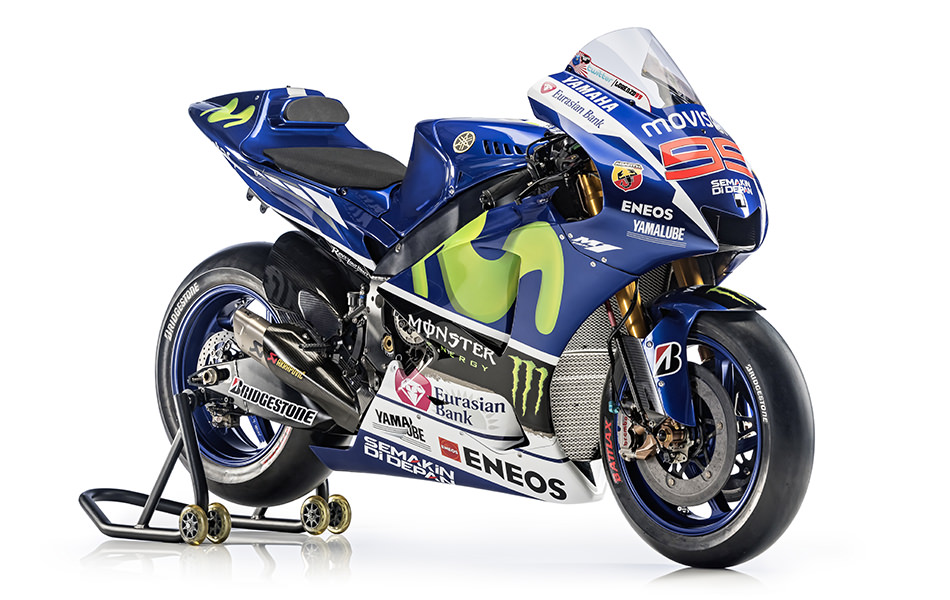
2015 YZR-M1
Engine: 1,000cc liquid-cooled in-line 4-cylinder with crossplane crankshaft
Frame: Aluminum Deltabox
Tires: 16.5-inch front and rear
Weight: 158 kg
Maximum output: Over 240 hp
It made me wonder what the bike’s actual power output is. All of the manufacturers in MotoGP list the official power output of their machines at or over roughly 240 hp, but I’m sure that the YZR-M1 has far more than just 40 to 50 hp over the new R1, even considering the difference in gear ratios. I’ve heard people say that it was near 300 hp and that doesn’t sound like much of an exaggeration anymore. As you may know, it’s possible for MotoGP bikes to reach speeds close to 350 km/h even on a straight that isn’t very long. Furthermore, the time spent to get to such speeds is just one moment of endless and incredible acceleration.
As I saw the last turn of the circuit approaching fast, I quickly sat up and began braking. As soon as I did, my helmet jerked around in every direction from the sudden and jarring wall of wind hitting it. Now extremely tense and not knowing how hard to apply the brakes, I unconsciously pulled hard on the lever. The stopping power was so astonishing that I impulsively blurted out, “Whoa!” However, there was no sudden lunge forward and the nosedive was so well controlled that it made me think, “Wait, that’s it?!” I gradually felt the tremendous deceleration g-forces grip my shoulders like they were trying to drag my whole upper body forward. Without any leeway to remember things like ABS being prohibited in MotoGP, I instinctively let out the brake lever. But by that time, I had already dropped off so much speed that I almost came to a stop at the entrance to the last corner.
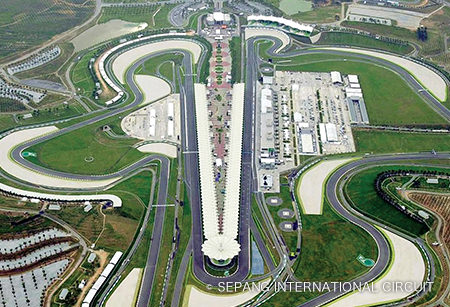
Sepang International Circuit
This world-class racetrack located on the outskirts of Kuala Lumpur hosts the Malaysia round of MotoGP as well as the official pre-season tests.
I began to accelerate again while leaning the machine to the left. The YZR-M1 turned so sharply that I found the machine rapidly approaching the inside of the turn. Rather than saying the bike “corners,” it might be better to say that it traces the ideal line of the corner itself. Pivoting on the rear wheel, the front wheel traces the line on the outside and I could barely detect any difference between the movement of the two wheels.
While listening to my mind argue with itself (“I think I’m starting to get used to it”; “Nope, you’re just kidding yourself.”), I headed onto the long straight with the machine gradually coming upright out of its lean and opened up the throttle to a point a little less than I had before [on the back straight].
Then that astounding rush of acceleration came again. The YZR-M1 has a digital tachometer like the YZF-R1M, but I don’t have the leeway to check it. Am I already near redline? The LCD rpm display moves rapidly across the gauge toward the right and the shift lamp has already come on when I finally upshift.
When I reached about the middle of the straight and tried to upshift one more time, I realized I was already in 6th (top) gear. Simply amazing power! Because of the tremendous pressure tugging on the back of my helmet and down along my back, virtually trying to pull me to the rear, I squeezed the fuel tank desperately with both elbows and tried to thrust my face forward to hold out against the forces at this speed. It’s the straights that are most demanding of all on the rider’s strength...at least that’s how it was for me since I’m not used to these speeds. The YZR-M1 was propelling me to speeds far above what I’d experienced on the YZF-R1M at the Yamaha Test Course, that much was certain.
(Continue to Part 2)


